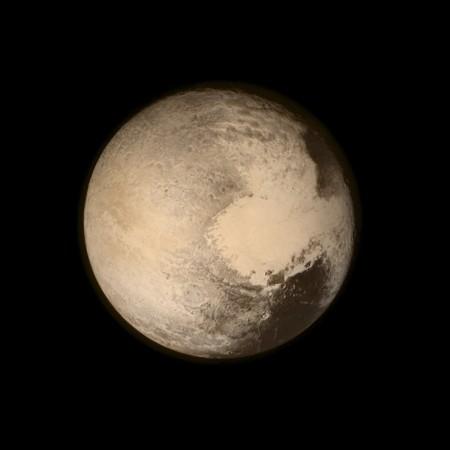
The dwarf planet Pluto hints towards having an underground ocean located beneath the heart shaped surface of its frozen central plain. The amount of water in the ocean is estimated to be equal to the volume of water in all the seas Earth possesses.
This finding was revealed on Wednesday, November 16 2016 and the research is published in the journal Nature.
Located around 150 to 200 km (93 to 124 miles) below Pluto's surface, the ocean is believed to be slushy with ice and 100 km (62 miles) deep, Francis Nimmo, a planetary scientist from the University of California, Santa Cruz stated in an interview.
This ocean is believed to serve as a habitat for life forms, but Massachusetts Institute of Technology planetary scientist Richard Binzel said that Pluto is not the prime candidate for life as its ocean is enveloped with too much of ice. Liquid water is considered to be crucial for life forms to survive.
But Binzel also said that "one is careful to never say the word impossible," Reuters stated.
This amazing discovery was made by observing the data and photos gathered by NASA's New Horizons spacecraft in July 2015, when it passed by the dwarf planet and its moons.
"It shows that nature is more creative than we are able to imagine, which is why we go and explore," Binzel said, as reported by Reuters. "We see what nature is capable of doing," he added.
This finding also revealed the fact that despite being located 40 times farther from the Sun in comparison to the Earth, Pluto still got leftover radioactive heat in abundance since its formation, which took place 4.6 billion years ago, that can keep the water in liquid form.
"Pluto has enough rock that there's quite a lot of heat being generated, and an ice shell a few hundred kilometres thick is quite a good insulator," said Nimmo, the Reuters report quoted. "So a deep sub-surface ocean is not too surprising, especially if the ocean contains ammonia, which acts like an anti-freeze," Nimmo added.
The scientists were analysing the 1,000 km wide basin, Sputnik Planitia, comprising of the curiosity arising heart shaped area of the dwarf planet located near Pluto's equator. They discovered the existence of the slushy ocean during this analysis.
Pluto's basin was shown stuffed with ice by the computer models, which is believed to have caused the planet to roll over and crack its crust. This is possible only if Pluto had a sub-surface ocean, as per the study.
On January 1 2019, the New Horizons spacecraft will be sent to space for another mission to search for another frozen world named present in the Kuiper Belt region, named 'known as 2014 MU69'. The Kuiper belt circumstellar disc is situated 1.6 billion km after Pluto.

















